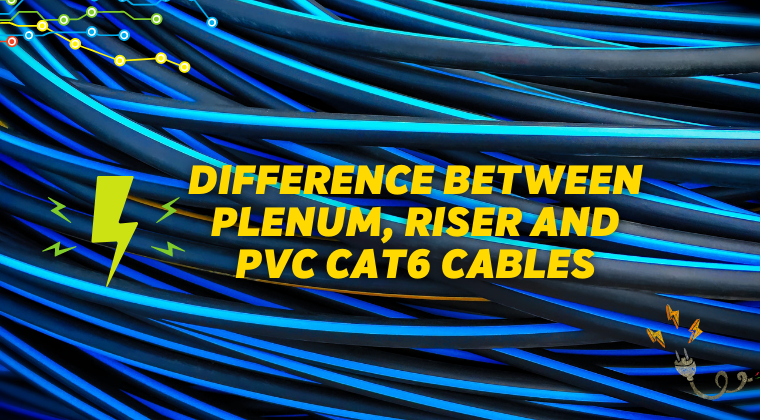All three cables Cat6 Plenum Cable, Cat6 Riser Cable, and Cat6 PVC cable remain the most updated additions in the modern tech cabling system. Still, they differ vastly in specs. When it comes to Cat6 Riser cables, they are mostly used for installation in residential areas. Owing to the very same reason, these types of cables don’t follow stringent safety measures.
As the name indicates, Cat6 Plenum Cable is used for installation in indoor spaces –especially in the plenum spaces– as they are more fire-resistant and made of supreme-quality material. Usually, FEP or Teflon is used to make plenum cables making them less poisonous (when they burn). The jacket of Cat6 PVC cables is constructed from Polyvinyl Chloride. If burnt, this jacket releases toxic dioxin and hydrochloric acid; both of these are toxic. For comparison purposes, we will list some of the most noteworthy factors that will help you in making an informed decision when purchasing ethernet cables.
Safety Standard
All aforementioned cables meet different safety standards. All of these cables are Underwriter Laboratories (UL) certified. This certification guarantees these ethernet cables are 100% solid copper.
Cat6 Plenum Cable comes in 23 AWG wire and is accompanied by 8 conductors and 4 unshielded twisted pairs. Cat6 Riser Cable also comes in 23 AWG wire and 4 unshielded twisted pairs. The difference is that Cat6 Riser Cable is accompanied by UL 1666 safety standard whereas Cat6 Plenum comes in UL910 safety standard; the former is a bit more linear than the latter. Owing to the very same reason, the demand for Cat6 Plenum is higher than its riser counterpart. As a matter of fact, plenum cable is often used as an alternative for the riser; the roles can’t be reversed.
Installation Temperature
Cat6 PVC Cable has an installation temperature range of 0 degrees Celsius to 60 degrees Celsius; the same is the temperature for plenum cable. The installation temperature range for Cat6 Riser is also between 0 degrees Celsius to 60 degrees Celsius.
Cable Jacket
The material used in jackets of PVC cables is Polyvinyl Chloride. As this material is highly fired prone, it can’t be used in plenum spaces or other indoor spaces. Usually, PVC cable is recommended for outdoor installations. Plenum cables come in CMP jackets that are fire retardant; it means this cable is highly fire-resistant and not readily susceptible to fire. As a matter of fact, its CMP jackets actually prevent fire progression. Riser cables come in riser-rated jackets making them the perfect choice for usage in non-plenum areas.
Data Transfer Speed
As all 3 cables belong to the Cat6 family, they have relatively higher data transfer speeds. The data transfer speed of Cat6 Plenum is 1 Gigabit per second; the same is for Cat6 Riser and Cat6 PVC. The operating frequency of all 3 cables is 550 MHz. It means less crosstalk and less interference.
Usage
Due to their high safety standards, plenum cables are used in plenum spaces. They are also often used as an alternative for riser cables in riser spaces. Riser cables are used in riser spaces. However, they cannot be a replacement for plenum cables as used in these spaces demands higher resistivity to extreme temperatures. PVC cables are perfect for usage in open spaces or outdoor installations.
Price
Whatever cable you choose, the price remains the key factor when making a final decision. As plenum cables come with higher safety standards and premium material is used, their price is on the higher end. It ranges anywhere between $215 to $275 per 1000 feet. Because they usually come in thick jackets, several people used them in riser places without any hesitation. The price range for riser cable ranges anywhere between $60 to $110 per 1000 feet. When compared with plenum cables, their material is not that brilliant; they can’t be used as a replacement for plenum cables. The price range for Cat6 PVC cable is almost similar to that of riser cable. It means the price varies between $60 to $100 per 1000 feet.


